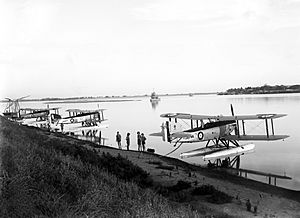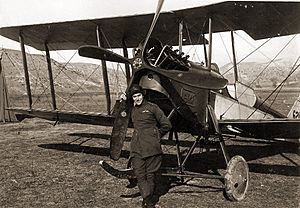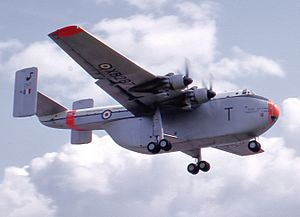No. 47 Squadron RAF facts for kids
Quick facts for kids No. 47 Squadron RAF |
|
|---|---|

Squadron badge
|
|
| Active | 1 March 1916 – 1 April 1918 (RFC) 1 April 1918 – 7 October 1919 (RAF) 1 February 1920 – 21 March 1946 1 September 1946 – 31 October 1967 25 February 1968 – 30 June 2023 |
| Country | |
| Branch | |
| Type | Flying squadron |
| Motto(s) | Nili nomen roboris omen (Latin for 'The name of the Nile is an omen of our strength') |
| Battle honours |
|
| Insignia | |
| Squadron badge heraldry | In front of a fountain, a demoiselle crane's head erased. The unofficial badge had been a sun rising over a pyramid, but tours in Russia and Sudan inspired the use of a crane (found in both countries) which, when navigating, flies high like a bomber. The fountain commemorates the amphibious role when seaplanes were flown off the River Nile. Approved by King George VI in November 1938. |
| Squadron Codes | EW (Apr 1939 – Sep 1939) KU (Sep 1939 – Sep 1942) (Feb 1945 – Mar 1946) |
No. 47 Squadron was a special flying unit of the Royal Air Force (RAF). It was based at RAF Brize Norton in Oxfordshire, UK. The squadron flew Hercules C4/C5 planes from 2013 to 2023. Before that, it used the Hercules C.1/C.3 from 1968 to 2013. The squadron was officially closed down on June 30, 2023.
Contents
History of No. 47 Squadron
First World War Service
No. 47 Squadron was created on March 1, 1916. It started as a home defence unit in Beverley, East Riding of Yorkshire. Its job was to protect places like Hull from German airships called Zeppelins. The squadron used different types of planes, including the Armstrong Whitworth F.K.3 and Royal Aircraft Factory BE.12.
After six months of training, part of the squadron moved to Salonika in Greece. They arrived on September 20, 1916. Their mission was to support forces fighting on the Macedonian Front. The squadron used some planes for scouting and bombing, and others for fighting.
In 1918, the Royal Flying Corps became the Royal Air Force. The fighter planes from No. 47 Squadron then formed a new unit, No. 150 Squadron. No. 47 Squadron continued using Armstrong Whitworth F.K.8s for scouting. They also bombed Bulgarian forces during their retreat in September 1918.
Between the World Wars
After World War I, in April 1919, the squadron went to Southern Russia. They helped General Denikin's forces fight against the Bolsheviks in the Russian Civil War. Even though the RAF's main job was training, No. 47 Squadron flew bombing and attack missions. They used Airco DH.9 and Airco DH.9A bombers, and Sopwith Camel fighter planes.
One famous event happened on July 30, 1919. A DH.9 plane was shot down. Another pilot, Captain Anderson, landed his damaged plane to rescue the crew. He and his gunner, Lieutenant Mitchell, were given the Distinguished Service Order for their bravery. No. 47 Squadron was closed on October 7, 1919.
The squadron was re-formed on February 1, 1920, in RAF Helwan, Egypt. It became a bomber squadron using DH.9 planes. Later, they got Airco DH.9As. One of their jobs was to help keep peace in Sudan. They also helped map out the air route from Cairo to Baghdad and carried air mail.
In October 1927, the squadron moved to Khartoum. They got new Fairey IIIF planes. They were the first squadron to use this aircraft. They worked with the Sudan Defence Force, patrolling borders. Some IIIFs were fitted with floats to fly over the River Nile and the Red Sea. They also made long flights, including trips to South Africa. In 1933, they switched to Fairey Gordon planes.
In 1936, the squadron started using Vickers Vincent planes. By June 1939, they began flying the Vickers Wellesley monoplane. They kept some Vincents for working with the army.
Second World War Operations
East Africa and the Mediterranean
When Italy joined World War II, No. 47 Squadron moved to Erkowit. Their first combat mission was on June 11, 1940, attacking an airfield in Eritrea. A part of the squadron, D Flight, became No. 430 Flight. They supported Orde Wingate's special forces.
In December 1940, No. 47 Squadron received more Wellesleys from No. 14 Squadron. By April 1941, they were the only unit flying Wellesleys in East Africa. They bombed Italian forces until they surrendered in May 1941. Then, they supported British forces in Ethiopia, dropping supplies until the Italians surrendered in Gondar in November 1941.
The squadron then moved to Egypt. They used their Wellesleys for anti-submarine patrols in the eastern Mediterranean. In July 1942, they got Bristol Beaufort torpedo bombers. They attacked enemy ships supplying the Afrika Korps in Libya. They continued these missions until 1943. In June 1943, the squadron, based in Tunisia, got Bristol Beaufighters. These planes were better for attacking enemy ships in the Mediterranean and Aegean Sea.
India and the Far East
In March 1944, the squadron moved to India with their Beaufighters. In October, they tried using de Havilland Mosquito planes. However, the Mosquitoes had problems in the hot, humid Indian climate. So, they went back to using Beaufighters in November. They used them to support operations in Burma, attacking with rockets day and night.
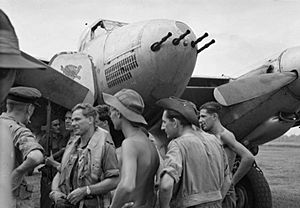
In February 1945, they partly re-equipped with Mosquitoes. Both Beaufighters and Mosquitoes were heavily used to support General Slim's army in its attack on Mandalay. By April 1945, they were fully equipped with Mosquitoes. They continued fighting Japanese forces until the war ended. After the war, they moved to Java to operate against Indonesian forces. The squadron was closed down on March 21, 1946.
Transport Role (1946–1967)
On September 1, 1946, the squadron was re-formed in Palestine. It became a transport squadron, using four-engine Handley Page Halifax bombers that had been changed for transport. Soon, they moved back to the United Kingdom. They flew the Halifax from RAF Fairford to support the Army.
In September 1948, the squadron moved to RAF Dishforth. They became the first RAF squadron to receive the Handley Page Hastings transport plane. These planes were urgently needed for the Berlin Airlift. The squadron moved to Schleswigland in West Germany on November 1, 1948. Their planes mainly carried coal, making 3,000 trips to Berlin and carrying 22,000 tons of supplies. When the blockade ended, the squadron returned to the UK. They moved to RAF Topcliffe in August 1949 and then to RAF Abingdon in May 1953.
In May 1956, the squadron was the first to get the Blackburn Beverley heavy-lift transport plane. These large aircraft were used for carrying troops and cargo. The squadron also supported operations in Cyprus, Kuwait, and East Africa. They flew mercy missions during floods and other natural disasters. The Beverley planes were retired, and the squadron was closed on October 31, 1967.
Hercules Aircraft Era (1968–2023)
C-130K Hercules Operations
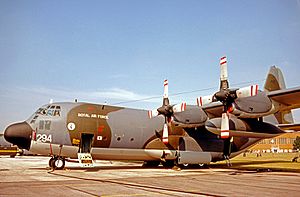
The squadron was re-formed at RAF Fairford on February 25, 1968. Their new aircraft was the Lockheed C-130K Hercules. They moved to RAF Lyneham in September 1971.
During the Falklands War, the squadron flew supplies to Ascension Island. They also dropped men and supplies to British ships in the South Atlantic. Some Hercules planes were given extra fuel tanks for the long trip to the Falklands. The Hercules C.1/C.3 planes were retired on October 28, 2013.
C-130J Super Hercules Operations
No. 47 Squadron received its first Lockheed Martin C-130J Super Hercules on November 21, 1999.
The squadron was very involved in Operation Telic in Iraq in the 2000s. They also took part in Operation Ellamy in Libya in 2011. The squadron moved to RAF Brize Norton in 2011.
In March 2020, the squadron was honored for its role in the War in Afghanistan (2001–2014). On June 4, 2023, No. 47 Squadron flew the RAF's last Hercules operational flight. A Hercules C4 plane returned from RAF Akrotiri, Cyprus, to RAF Brize Norton.
On June 8, 2023, No. 47 Squadron held its closing parade at RAF Brize Norton. This event was led by the Princess Royal. The squadron officially closed on June 30, 2023, because the RAF retired the Hercules aircraft. On June 23, 2023, at a farewell party for the Hercules, 47 Squadron's band performed with singer Bruce Dickinson from the band Iron Maiden.
The squadron officially closed on June 30, 2023, when the RAF stopped using the C-130 Hercules.


